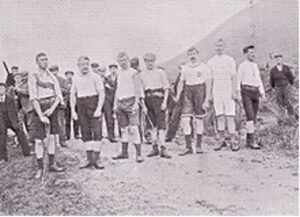Ben Nevis history and facts
This article covers Ben Nevis history and facts. If you have always dreamed of climbing Ben Nevis come and do that with us on our Ben Nevis Guided Walks.
Ben Nevis, highest mountain of the British Isles, in the Highland council area, Scotland. Its summit, reaching an elevation of 4,406 feet (1,343 metres). Snow lies in some parts all year, and permafrost conditions are almost reached. Each year, 150,000 people hike Scotland’s Ben Nevis.
Most take the so-called tourist trail, the rocky path which winds and zigzags its way to the summit. Few realise that this path was initially carved out in 1883 for a very unique scientific expedition. Even fewer know that now, more than a century later, this site is providing UK scientists with insights into climate change.
Back in Victorian Britain, science was still largely an amateur pastime conducted by bands of self-financed enthusiasts who formed scientific societies. One was the Scottish Meteorological Society, which set up and maintained a network of weather stations across Scotland between 1855 and 1920.
At the time, a key question was how depressions, storms and other severe climatic events form in the atmosphere. By 1875 mountain observatories were being established across the US, Mexico, India, France, Germany and Russia.
The Victorian meteorologists risked their lives to collect weather readings from Scotland’s Ben Nevis. Today, their sacrifices are helping us understand the effects of climate change.
And so began a remarkable experiment in Victorian stoicism and scientific endeavour. From 1883 to 1904, a few hardy individuals lived year-round in a small stone hut, surviving on tinned food and making hourly recordings of everything from atmospheric temperature to humidity, wind speed to rainfall. In total they made almost 1.5 million observations – often going to extraordinary lengths and risking their lives to record data in the most hostile of conditions.
The harsh realities of life at the top of a mountain quickly became apparent during the first winter of 1883. With heavy blizzards leaving the entire summit covered in a 5ft (1.5m) layer of snow, the three weathermen found themselves snowed in to such an extent that they had to repeatedly dig tunnels just to get out.
The summit observatory was built in the summer of 1883, and would remain in operation for 21 years. The first path to the summit was built at the same time as the observatory and was designed to allow ponies to carry up supplies, with a maximum gradient of one in five. The opening of the path and the observatory made the ascent of the Ben increasingly popular, all the more so after the arrival of the West Highland Railway in Fort William in 1894. Around this time the first of several proposals was made for a rack railway to the summit, none of which came to fruition.
Under ideal conditions, it can extend to over 190 kilometres (120 mi), including such mountains as the Torridon Hills, Morven in Caithness, Lochnagar, Ben Lomond, Barra Head and to Knocklayd in County Antrim, Northern Ireland.
Would you like to walk to the summit of Ben Nevis? Come on a guided Ben Nevis walk with us.
Driving to the summit
In May 1911,Henry Alexander Jr. the son of Henry Ford drove a Ford Model T car to the summit of Ben Nevis. The publicity stunt was to prove that their American made vehicles were much superior to what the British could produce. The idea of driving a Model T to the top of Britain’s highest mountain was the brainchild of Henry Alexander, a motor dealer in Edinburgh.
The Model T had rolled off a production line in the US for the first time three years earlier, and Alexander wanted to mount a publicity stunt to demonstrate that the imported, mass produced American cars were superior to hand-crafted British ones.
The footage of the bone-shuddering drive back down the mountain was later thought to have been lost, before it was rediscovered in 2015.
Motoring Over Ben Nevis (1911) is part of the BFI National Archive and is available to watch for free as part of Britain on Film on BFI Player.
 Ben Nevis Race
Ben Nevis Race
The history of hill running on Ben Nevis dates back to 1895. William Swan, a barber from Fort William, made the first recorded timed ascent up the mountain on or around 27 September of that year, when he ran from the old post office in Fort William to the summit and back in 2 hours 41 minutes.
The Ben Nevis Race has been run in its current form since 1937. It now takes place on the first Saturday in September every year, with a maximum of 500 competitors taking part. It is 14 kilometres (8.7 mi) long with 1,340 metres (4,400 ft) of ascent.
We only intend to walk up ‘The Ben’ but it is still a great challenge.
[checkfront category_id=”5″ options=category_select]

Comments are closed